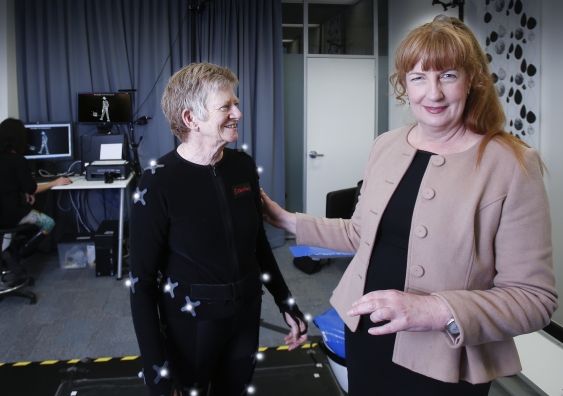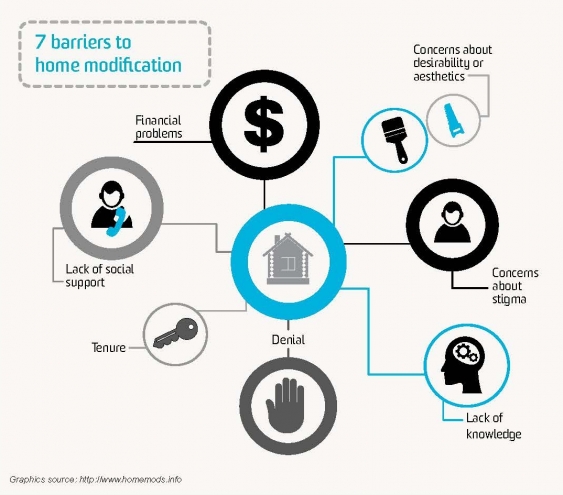Home to stay
Using state-of-the-art technology, Built Environment’s Catherine Bridge is working with industry to develop a new generation of products that will empower older Australians to live in their homes for longer.
Using state-of-the-art technology, Built Environment’s Catherine Bridge is working with industry to develop a new generation of products that will empower older Australians to live in their homes for longer.

An older woman moves around a bathroom, stepping in and out of spaces that we all routinely navigate each day. But this is no ordinary room. Equipped with state-of-the-art biometrics technology, it tracks the woman’s every movement via pressure mats and 3D hand scanning.
Part of UNSW Built Environment’s Liveability Lab, the ‘bathroom’ is collecting a vast amount of data about how older bodies interact with objects and fittings such as toilets and handrails, and about what is functional and appealing.
The aim is to create a new generation of products that not only improve usability for older people, but also helps them stay in their homes longer.
“It’s important to allow people to remain in their own homes and be mobile and be able to enjoy their life,” says Associate Professor Catherine Bridge, of the drive to make house modifications aspirational and elegant for the burgeoning number of older Australians. “It’s about having a better quality of life. And being safe.”
By 2020, for the first time in human history, there will be more people in the world aged 65 or over, than those under the age of five. Almost one in five of the oldest will have a severe handicap posing a major care burden for governments.
“If we are talking about deinstitutionalisation, if we’re talking about social inclusion then we really have to address this,” Bridge says. “And if we don’t address it for the most vulnerable people in our society on the lowest incomes then we really haven’t done the right thing.”

As research leader at UNSW’s Enabling Built Environments Program, Bridge is responsible for collating and making sense of the data the Liveability Lab collects.
Established with a $446,000 ARC Linkage Grant, matched with cash and in-kind support from bathroom products firm Caroma and GWA Bathrooms and Kitchens, as well as a $225,000 major research equipment and infrastructure grant from UNSW, the lab’s end result will be innovative products.
Demand for such products will only increase with the introduction of the National Disability Insurance Scheme, giving its clients more autonomy and choice, Bridge predicts.
Former occupational therapist, 69-year-old Penny Plumbe is one of six co-designers assisting with the Liveability Lab’s research. The group was the first to test the lab’s equipment in preparation for the first intake of research participants, as well as playing an integral role in brainstorming how current bathroom products can be modified.
“I get a great deal of satisfaction from being involved in research and education,” Plumbe says. “And as an older person I can appreciate how these products will assist people wanting to stay in their own homes for longer.”
Making a practical difference is central to Bridge’s agenda. More than most architects, she is uniquely qualified to know what modifications need to be made to the built environment as our physical and mental capabilities change.
Originally trained as an occupational therapist, she did a Masters in Cognitive Science, before completing her PhD in Architecture – experiences that shaped her belief that buildings “embody society’s values” and are a tool of social agency.
“You can change a person, you can help them to relearn skills or to use assisted technology or to delegate tasks, but if you are really interested in an inclusive society the only way to do that is to change the built infrastructure,” she says.
That philosophy has led to another practical service: the world-leading Home Modifications Information Clearinghouse, a web-based, one-stop-shop for consumers, designers and industry. The online service collates evidence-based best practice for home modifications ranging from very simple DIY guidelines to design tools for architects drafting access-friendly homes.
Based within the faculty, and directed by Bridge, the site has been used by more than 200,000 people in 190 countries. The service was nominated for a NSW Premier’s Public Service Award in 2006.
“There are other groups in the inclusive design space and we work with them extensively, but there really is no other service of its kind in terms of providing specific home modification information,” says Bridge.
Staff at the Clearinghouse comb academic literature and translate new findings into user-friendly fact sheets for consumers and industry and harvest data about real-world problems from online forums for occupational therapists, designers and the general public.
The do-it-yourself modifications marketplace is already booming – a recent study for the NSW government conducted by Bridge identified that provision of five product types, including hand showers, can offset health and aged care costs in the order of $3.75 million per year. The lower costs are a result of all aspects of planning, product selection, purchase and installation or construction being undertaken by privately funded individuals or their family and friends.
For Bridge, the emphasis is on style as much as function, with aesthetics a major barrier and disincentive to renovations that could keep people out of residential care, potentially saving millions of dollars.
“People reject the services because they don’t want their home looking like a hospital or an ugly ramp at their front door,” says Bridge, pointing to a recent survey in which one respondent said simply, “I want to have a say in how things are going to be renovated, how they look”.
“Housing is the largest asset that most people own, and people are very reluctant for a range of reasons, including inheritance, to reduce the value of their asset,” she explains. “If they perceive that modifications are going to make their home less saleable or reduce its value, it becomes problematic.”
Apart from significant government savings, work by Bridge and PhD candidate Phillippa Carnemolla at both the Liveability Lab and the Clearinghouse has shown that home modifications also increase quality of life across every measure for older people and those with a disability.
Most importantly, Bridge says, they improve people’s relationships, shifting the carer–client dynamic back to one where both parties feel empowered and respected “and that’s what it’s all about”.